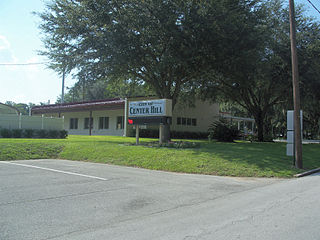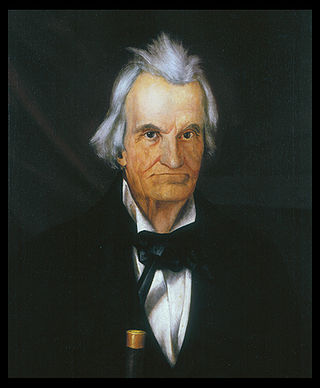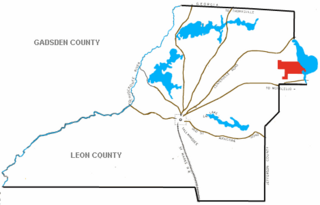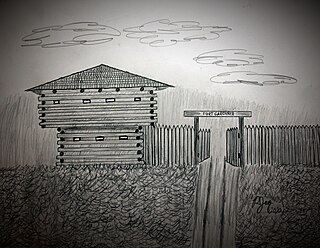
The Seminole Wars were a series of three military conflicts between the United States and the Seminoles that took place in Florida between about 1816 and 1858. The Seminoles are a Native American nation which coalesced in northern Florida during the early 1700s, when the territory was still a Spanish colonial possession. Tensions grew between the Seminoles and settlers in the newly independent United States in the early 1800s, mainly because enslaved people regularly fled from Georgia into Spanish Florida, prompting slaveowners to conduct slave raids across the border. A series of cross-border skirmishes escalated into the First Seminole War in 1817, when General Andrew Jackson led an incursion into the territory over Spanish objections. Jackson's forces destroyed several Seminole and Black Seminole towns and briefly occupied Pensacola before withdrawing in 1818. The U.S. and Spain soon negotiated the transfer of the territory with the Adams-Onis Treaty of 1819.

Center Hill is a city in Sumter County, Florida, United States. The population was 988 at the 2010 census. According to the U.S Census estimates of 2018, the city had a population of 1,409.

The Second Seminole War, also known as the Florida War, was a conflict from 1835 to 1842 in Florida between the United States and groups of people collectively known as Seminoles, consisting of Native Americans and Black Indians. It was part of a series of conflicts called the Seminole Wars. The Second Seminole War, often referred to as the Seminole War, is regarded as "the longest and most costly of the Indian conflicts of the United States". After the Treaty of Payne's Landing in 1832 that called for the Seminole's removal from Florida, tensions rose until fierce hostilities occurred in the Dade battle in 1835. This conflict started the war. The Seminoles and the U.S. forces engaged in mostly small engagements for more than six years. By 1842, only a few hundred native peoples remained in Florida. Although no peace treaty was ever signed, the war was declared over on August 14, 1842.

The Battle of Wahoo Swamp was an extended military engagement of the Second Seminole War fought in November 1836 in the Wahoo Swamp, approximately 50 miles northeast of Fort Brooke in Tampa and 35 miles south of Fort King in Ocala in modern Sumter County, Florida. General Richard K. Call, the territorial governor of Florida, led a mixed force consisting of Florida militia, Tennessee volunteers, Creek mercenaries, and some troops of the US Army and Marines against Seminole forces led by chiefs Osuchee and Yaholooche.

Thomas Metcalfe, also known as Thomas Metcalf or as "Stonehammer", was a U.S. Representative, Senator, and the tenth Governor of Kentucky. He was the first gubernatorial candidate in the state's history to be chosen by a nominating convention rather than a caucus. He was also the first governor of Kentucky who was not a member of the Democratic-Republican Party.

Duncan Lamont Clinch was a slave-plantation owner and an American army officer who served as a commander during the War of 1812, and First and Second Seminole Wars. In 1816, he led an attack on Negro Fort, the first battle of the Seminole Wars. Clinch later served in the United States House of Representatives, representing Georgia.

Francis Wayles Eppes was a planter and slave owner from Virginia who became a cotton planter in the Florida Territory and later civic leader in Tallahassee and surrounding Leon County, Florida. After reaching legal age and marrying, Eppes operated the Poplar Forest plantation which his grandfather President Thomas Jefferson had established in Bedford County, Virginia, which he inherited. However, in 1829 he moved with his family to near Tallahassee, Florida. Long interested in education, in 1856 Eppes donated land and money to designate a school in Tallahassee as one of the first two state-supported seminaries, now known as Florida State University. He served as president of its board of trustees for eight years.

Ingleside Plantation was a forced-labor farm of 2,620 acres (1,060 ha) located in extreme northeast Leon County, Florida and established by Robert W. Alston and his family. Eventually, the property was acquired by Joel C. Blake. In 1860, Blake was enslaving 116 people to work his land, which was mostly devoted to producing cotton as a cash crop.

Fort Braden is a historic location and census-designated place (CDP) in western Leon County, Florida, United States. It was first listed as a CDP in the 2020 census with a population of 1,045.

Tsala Apopka Lake is a chain of lakes located within a bend in the Withlacoochee River in Citrus County in north central Florida. This area is known historically as the Cove of the Withlacoochee.

George Taliaferro Ward was a major cotton planter and politician from Leon County, Florida. He served in the Confederate Army as a colonel during the American Civil War, dying near Williamsburg, Virginia.
Robert West Alston was a cotton planter who lived near Lake Miccosukee, Leon County, Florida. Alston was originally from Halifax County, North Carolina, and came to Florida by way of Hancock County, Georgia.
The Battle of Withlacoochee, otherwise known as the Battle of Ouithlacoochie, was a battle in the Second Seminole War, fought on December 31, 1835, along the Withlacoochee River in modern Citrus County, Florida.
Uchee Billy or Yuchi Billy was a chief of a Yuchi band in Florida during the first half of the 19th century. Uchee Billy's band was living near Lake Miccosukee when Andrew Jackson invaded Spanish Florida during the First Seminole War and attacked the villages in the area. Yuchi Billy and his band then moved to the St. Johns River. During the Second Seminole War, Uchee Billy was an ally of the Seminoles, and was one of the principal war chiefs who fought the U.S. Army.
Leigh Read County was a county in Florida proposed to honor General and Legislator Leigh Read following his assassination. In 1842, the Democrats in the Florida Territorial Council passed a bill that would have renamed Mosquito County - which at the time included all of today's Orange, Seminole, and Volusia as well as parts of Lake, Osceola, Polk and Brevard counties - to Leigh Read County. Many claim that the bill did pass the Territorial Council, but there are no legislative records of the bill. What happened is unclear, but some claim a clerk withheld the bill, while others claim Whig Governor Richard K. Call, who routinely clashed with Read, refused to sign the bill. One historian says Governor Call claims to have signed the bill, "but through some misadventure the law never appeared on the books."
David Moniac, an American military officer, was the first Native American graduate of the United States Military Academy at West Point, New York in 1822. A Creek with some Scots ancestry, who was related to major Creek leaders on both sides of his family, Moniac was the first cadet to enter West Point from the new state of Alabama. Moniac resigned his commission in 1822 to manage his clan's property in Alabama, where he developed a cotton plantation.
Wahoo is an unincorporated community in Sumter County, Florida, United States. First settled by the Timucua, the area was eventually settled by the Seminoles. During the Second Seminole War, Wahoo and the surrounding area served as shelter to the Seminoles and as the site of several skirmishes. After the war, white settlers migrated to the area and established a thriving town.

Fort Gardiner was a stockaded fortification with two blockhouses that was built in 1837 by the United States Army. It was one of the military outposts created during the Second Seminole War to assist Colonel Zachary Taylor's troops to capture Seminole Indians and their allies in the central part of the Florida Territory that were resisting forced removal to federal territory west of the Mississippi River per the Indian Removal Act.

Benjamin Chaires Sr. (1786–1838) was an American planter, land owner, banker and investor in Territorial Florida, and may have been the richest man in Florida in the 1830s. He was involved in the creation of the first railroads in Florida.













